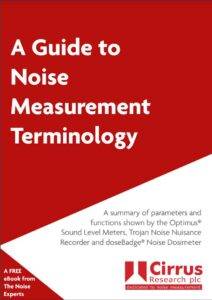What are Fast, Slow & Impulse Time Weightings?
LAS. LAF. LCS. LCF. These are common terms you probably see when taking a noise measurement with your sound level meter. The “F” and “S” indicate the different Time Weightings used for that measurement but what do they mean?

An Old Analogue Sound Level Meter from Cirrus Research – Complete with Time Weighting Functions
Fast, Slow and Impulse Time Weightings originate from a time before integrating sound level meters and way before digital sound level meters.
When sound level meters were first developed, they used analogue meters with needles that moved back and forth to give the user a reading. As noise levels almost never remain constant, the needle was always moving. A shorter needle would be able to move quicker than a longer, heavier needle and so the information given by two different instruments could be very different.
A set of standards were created to ensure that sound level meters from different manufacturers would display the same and these are known as Time Weightings. By effectively applying different weights to the needle, the speed at which the needle moved for a known noise level could be calibrated and measurements could be compared with one another.
Fast, Slow & Impulse Time Weightings
Fast Time Weighting
Fast corresponds to 125 milliseconds up and down. The needle would be moving much faster, showing you the varying noise levels quickly.
The Fast Time Weighting is usually used for measuring all the sound in your environment, which may vary widely over time. Therefore, you would need to report the range of noise fluctuations e.g. 58 to 64 dB (A). Fast is generally the chosen Time Weighting for noise measurements.
Slow Time Weighting
Slow corresponds to 1000 milliseconds up and down. By slowing down the needle, the noise measurements are easier to read as the data is smoothed out.
By using the Slow Time Weighting, you are recording sound levels at 1 second intervals. This smoother level history can give you a better indication of the average noise level in an environment where it is constantly changing.
Impulse Time Weighting
Impulse is the least common of the Time Weightings. It’s about four times faster than Fast (35 milliseconds) and is usually used to measure quick bursts of impulsive noise, generated by pile drivers or explosions. Impulse Time Weighting has often been used for the measurement from, for example, clay pigeon shooting ranges where there is a need to assess the short, impulsive noise created when a shotgun is fired.
The Impulse Time Weighting has a fast rise but a slower decay, which was designed to mimic the ear’s response to these types of sound. However, the Peak Time Weighting is now used to measure the true Peak values of impulsive sounds. It is often specified for measurement in Regulations, such as the 2005 Control of Noise at Work Regulations. Peak is the maximum sound pressure reached at any instant during a measurement period.
Time Weightings in Digital Sound Level Meters

The Latest Generation – A Digital Optimus® Sound Level Meter from Cirrus Research records all Time Weightings simultaneously
Even though we’ve moved into the digital age, Time Weightings are still calculated and simulated by sound level meters for the end user. Depending on the function you choose, the decibel reading on your LED display will change faster or slower.
The reason we still use Time Weightings is that they were set out in the Standards for acoustic equipment, which haven’t changed to this day. This means that no matter what generation of sound level meter you are using, you can clearly indicate the parameters you used to take your noise measurement.
Time Weightings are usually displayed alongside A, C or Z Frequency Weightings to give you the noise level you need for your assessment. The abbreviations used at the beginning of this article express how the sound level was measured:
- LAS – Slow, A-Weighted Sound Level
- LAF – Fast, A-Weighted Sound Level
- LCS – Slow, C-Weighted Sound Level
- LCF – Fast, C-Weighted Sound Level
Why do we note down these terms when measuring sound levels? It’s so you can ask anyone to measure the sound level using the same parameters to hopefully achieve same results. You also have to report them for the various Regulations that govern noise measurement for different applications.
Time Weightings are still an important parameter for environment noise monitoring rather than workplace noise monitoring. In the UK for example, you only need to measure using LEQ with the A-Frequency Weighting to comply with the 2005 Control of Noise At Work Regulations, so Time Weighting isn’t necessarily required. However, I always recommend you refer to the Regulations that you are required to meet first and check what noise level data you require for compliance.
Finding the Right Sound Level Meter
Time Weightings and Frequency Weightings are standard parameters in our Optimus® Sound Level Meters. The Fast and Slow Time Weighting readings are calculated and stored simultaneously for any noise measurement you make, so you can always refer back to them. You can find the ideal sound level meter for you by using our Optimus® Selector. Simply choose the applications, features and functions you require and we’ll recommend the best instruments for you.
Jaymee-lee Tolliday
Latest posts by Jaymee-lee Tolliday (see all)
- Turning Down the Volume: How the Trojan Noise Nuisance Recorder can help create a quieter world - 13th February 2024
- Festive Opening Hours 2023 - 6th December 2023
- Award of Excellence for Cloud-Based Monitoring Solutions 2023! - 20th November 2023

